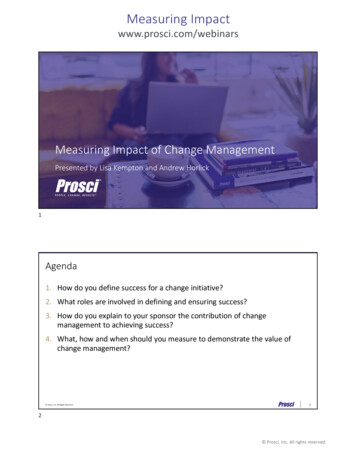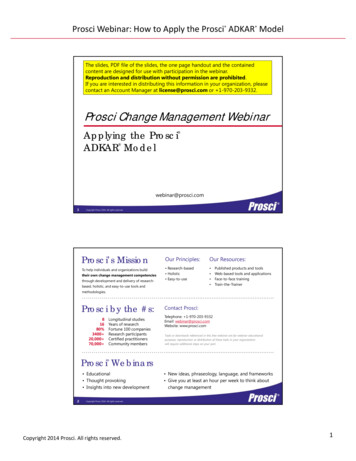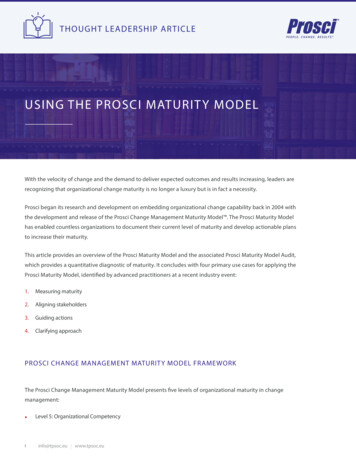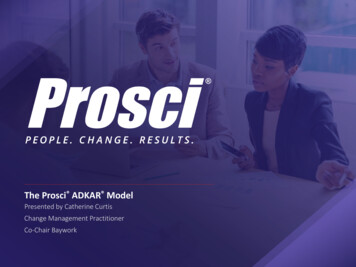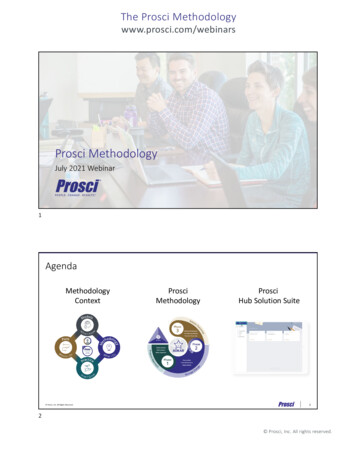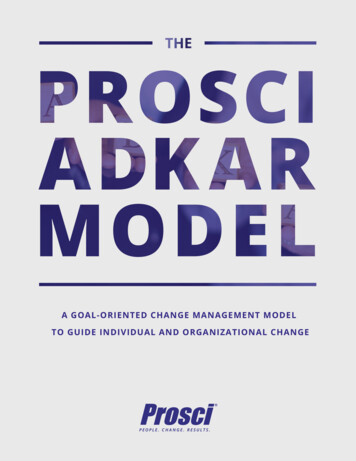
Transcription
Prosci Inc. All rights reserved. www.prosci.com1
CONTENTSWHY THE ADKAR MODEL?3UNDERSTANDING CHANGE AT AN INDIVIDUAL LEVEL3USING ADKAR WITH TRADITIONAL CHANGE MANAGEMENT ACTIVITIES4FRAMEWORK OF A CHANGE INITIATIVE6THE BUSINESS DIMENSION OF CHANGE7THE PEOPLE DIMENSION OF CHANGE7HOW TO USE THE ADKAR MODEL8THE ADKAR MODEL IN A PERSONAL CHANGE8THE ADKAR MODEL IN AN ORGANIZATION10THE POWER OF ADKAR FOR MANAGING CHANGE13ADKAR EXERCISE - IMPLEMENTING THE ADKAR MODEL14ADKAR ASSESSMENT15APPLYING THE ADKAR ASSESSMENT RESULTS16ACTIONABLE STEPS16TO CONCLUDE17
WHY THE ADKAR MODEL?Change is often a complex and difficult process. Leading successful change in other people andacross whole organizations requires new thinking and new tools. The Prosci ADKAR Modelis a valuable framework for organizational leaders, change managers and project managers toeffectively lead a wide variety of changes. The lens of ADKAR reveals both key concepts thatinfluence successful change and actionable insights for implementing these concepts.UNDERSTANDING CHANGE AT AN INDIVIDUAL LEVELHaving the clearest vision or the most effectively-designed solution to a problem will not,alone, produce successful change. The secret to leading successful change is rooted inProsci and ADKAR are trademarks of Prosci, Inc., registered in the US and other countries Prosci Inc. All rights reserved. www.prosci.com3
something much simpler: how to facilitate change with one person.Change happens at the individual level. In order for a group or organization to change, allthe individuals within that group or organization must change. This means that in order toaffect change in our organizations, businesses and communities, we must first understandhow to affect change one person at a time. The Prosci ADKAR Model is a framework forunderstanding and managing individual change. It provides structure and tangible guidance forleaders who want to motivate change in others.ADKAR is an acronym that represents the five milestones or outcomes an individual mustachieve for change to be successfully realized: awareness, desire, knowledge, ability andreinforcement. When applied to organizational change, this model allows leaders and changemanagement teams to focus their activities on what will drive individual change and produceorganizational results collectively.The goals or outcomes defined by ADKAR are sequential and cumulative. They must beachieved in order. For a change to be implemented and sustained, an individual must progressthrough each of the milestones, starting with awareness.ADKAR was initially conceived through Prosci founder Jeff Hiatt’s early research to aligntraditional change management activities with project goals and results. The ADKARModel was first used to determine the effectiveness of change management activities likecommunication and training in achieving desired organizational change results.USING ADKAR WITH TRADITIONAL CHANGE MANAGEMENT ACTIVITIESThe ADKAR Model outlines an individual’s successful journey through change. Each step of themodel naturally aligns to typical activities associated with change management and articulatesclear goals for these activities. Prosci Inc. All rights reserved. www.prosci.com4
For example:1. Awareness of the business reasons for change. Awareness is a goal/outcome of earlycommunications related to an organizational change.2. Desire to engage and participate in the change. Desire is a goal/outcome of sponsorshipand resistance management.3. Knowledge about how to change. Knowledge is a goal/outcome of training and coaching.4. Ability to realize or implement the change at the required performance level. Ability is agoal/outcome of additional coaching, practice and time.5. Reinforcement to ensure change sticks. Reinforcement is a goal/outcome of adoptionmeasurement, corrective actions and recognition of successful change.In identifying the outcomes of change management activities, the ADKAR Model provides auseful framework for change management teams in both the planning and the execution oftheir work. Prosci Inc. All rights reserved. www.prosci.com5
THE FRAMEWORK OF A CHANGE INITIATIVEThe ADKAR Model can be used to identify gaps within your change management process.By breaking down a change into the parts of ADKAR, you will be able to see where and why achange is not working well. With this understanding, you can address the barrier points, provideeffective coaching for your employees and take the necessary steps to improve change success.The ADKAR Model is useful in: Diagnosing employee resistance to change Helping employees transition through the change process Creating a successful action plan for personal and professional advancement during achange initiative Developing a change management plan for your employeesChanges come to life on two dimensions: the business or project side of change and thepeople side of change. Successful change is a result of both dimensions of change maturingsimultaneously (see below). Project management and change management are complementarydisciplines with a common purpose of producing results and outcomes. Prosci Inc. All rights reserved. www.prosci.com6
THE BUSINESS DIMENSION OF CHANGEListed below are standard steps of a typical business change project. Whether formalized ina project management discipline or not, most managers will feel comfortable managing thesephases: Identify a business need or opportunity Define the project (scope and objectives) Design the business solution (new processes, systems and organizational structure) Develop the new processes and systems Implement the solution into the organizationTHE PEOPLE DIMENSION OF CHANGEEven with an effectively architected project plan, however, the most commonly cited reason forproject failure is problems with the people side of change.In parallel, the five steps or outcomes to be built on the people side of change are theelements of ADKAR: Awareness of the need for change Desire to participate and support the change Knowledge of how to change Ability to implement the change on a day-to-day basis Reinforcement to keep the change in place Prosci Inc. All rights reserved. www.prosci.com7
HOW TO USE THE ADKAR MODELLet’s look at two examples of the ADKAR Model in application, the first in a personal changescenario and the second in a professional change scenario. Following the examples, there is asimple ADKAR activity to help build a clearer understanding of the model and how to apply it.THE ADKAR MODEL IN A PERSONAL CHANGEAdding a regular physical exercise regimen is a personal change many people attempt butstruggle to sustain over time. Let’s look at each element of ADKAR in this context: Awareness: are you aware of the need to exercise? Why should you start an exerciseregimen? Some things that may build your awareness are reading articles or seeing newsreports that describe the health benefits of regular exercise, from weight control topreventing disease and reducing stress. Desire: do you have the personal motivationto start exercising? A lot of people are aware ofthe need to exercise but might not have foundthe personal desire to start. Desire is a veryindividual concept. Your motivation may be thatyou want to lose weight to better keep up withyour kids; or you have a need for more physicalstrength at work; or maybe you’re looking fora way to reduce anxiety. Regardless of whatyour motivation is, you must make a personaldecision to make this change, based on yourown unique motivations. Prosci Inc. All rights reserved. www.prosci.com8
Knowledge: do you know how to effectively and safely exercise? This is where you needto gain some knowledge. Perhaps you hire a personal trainer to teach you the basics,attend an exercise class with an instructor or order a workout video or book. In order toeffectively change, you need to know how. Ability: can you put your knowledge into practice? Just because you know how todo something, does not mean you can actually do it. We often need coaching whenimplementing new behaviors, so you may need additional practice time with a personaltrainer to build up to doing exercises effectively or with proper form. Or perhapsconflicting time commitments are preventing you from being able to exercise and youneed to rearrange other priorities to make the time. Reinforcement: do you have reinforcements in place to prevent you from reverting to yourold habits? In this example, you may have a reward system for yourself when you hit certainexercise milestones. Or you might have a workout buddy who holds you accountable forshowing up to the gym.Note that each of the five elements of the ADKARModel represents a particular result that youare trying to achieve. Also note that all elementsare cumulative and must be performed in order.If, for example, we skip past the desire to startexercising, all attempts to learn how to exercise (tobuild knowledge and develop ability) will be moreineffective, if not futile.Using exercise as our example, it is easy to tracehow change occurs on a personal level throughthe ADKAR Model. Now let’s consider how thisframework applies to employees in a professional environment and how you can helpinfluence their progress towards the desired outcome. Prosci Inc. All rights reserved. www.prosci.com9
THE ADKAR MODEL IN AN ORGANIZATIONJust as with a personal change, the ADKAR Model helps us understand an individual’s needsduring a change at work and directs what kind of support enables employees to successfullychange. The change we will look at is the implementation of a new software tool.AwarenessIf the new software is implemented and employees are not aware that any changes areneeded, their reaction might be:“This is a waste of time.”“It was working just fine before.”“They never tell us what’s going on!”A natural human reaction to change, even in the best circumstances, is to resist. Awarenessof the business or organizational need to change is a critical component to overcomingresistance.If, on the other hand, employees clearly understand that the old software version will no longerbe supported by the vendor, or that new software will help them meet customer needs moreeffectively, the reaction (based on increased awareness) could look very different:“How soon will this happen?”“How will this impact me?”“Will I receive new training?” Prosci Inc. All rights reserved. www.prosci.com10
DesireArmed with awareness that a change is required, an employee still may have low desire to login and use the new software:“I’m not interested in changing.”“What’s in it for me?”“I doubt they are really serious about this.”The employee’s personal motivators or barriers contribute to their level of desire to use thenew software. Each person could have their own unique reasons for engaging or resisting;sometimes reasons that are not even related to the change.If an employee has no desire to change, they may be labeled as difficult, inflexible, pessimisticor unsupportive. The best person to help a resistant employee is their direct manager orsupervisor, who is usually closest to the employee and able to translate the change into theemployee’s personal context. Managers need to engage in coaching conversations to helpconnect the change to personal motivators and to identify how barriers can be removed orminimized.KnowledgeOnly after awareness and desire are built should we begin providing detailed knowledge ofhow to use the new software. Unfortunately, it is often the case that an organization sees achange coming and the very first step that they take is to send employees to training. Theresult of this approach is that the investment in the training is not highly effective. Employeesare not engaged in the detailed functionality of the software because they are not prepared Prosci Inc. All rights reserved. www.prosci.com11
to learn. They may not even know whythey are there in the first place. Tomake the most of a training investment,it must come after initial awareness anddesire building.AbilityAfter helping employees gain intellectualunderstanding of how to navigate inthe software interface, there may still be a gap between knowledge and ability. Knowledgeis knowing what to do; ability is being able to actually put that knowledge into practice.Demonstrated ability to operate with the software in a live, real-world situation is where thechange actually takes place. If an employee has knowledge but not ability, you might hear:“I’m not getting these new steps right.”“I eventually get there but it takes me twice as long.”“I understand the manual, but when I have to do it, I freeze.”To bridge the “knowledge to ability gap,” employees will benefit from hands-on coaching andpractice using the software before go-live. This practice could happen in a formal trainingsetting or by working through a simulated live environment. The important factor is that theemployees using the software can try it out, make mistakes and identify questions in a safeenvironment. Often, employees simply need time to realize changes and the best thing we cando is to give them time to practice. Prosci Inc. All rights reserved. www.prosci.com12
ReinforcementThe final element of the ADKAR Model is reinforcement. The human brain is wired for habit.We are physiologically programmed to revert to our old habits. When reinforcement is not inplace, we see employees using work-arounds or relying on their old spreadsheets instead ofthe new software. We may hear things like:“The new way just takes too long; I’m going to keep doing it my way.”“I keep forgetting to include the new department.”To reinforce change, we need to monitor whether the change is being sustained or not.Who is logging in, following workflows and using the new software successfully? Where areindividuals recognizing new efficiencies in their work? With this information, the first stepis to celebrate and recognize where the change has taken hold. Positive recognition is agreat way to reward employees for working hard to make changes and demonstrate to theorganization that participating in the change is important. If some employees are revertingto work-arounds or old processes, follow-up is needed to understand where their barriersare. Do they need more training or coaching? Are they missing any of the ADKAR elements?Reinforcement confirms that they are expected to continue working in the new way.THE POWER OF ADKAR FOR MANAGING CHANGEApproaching change using the ADKAR Model will help you to plan effectively for a new change.Equally, if a current change is failing, the model can immediately diagnose where the process isbreaking down so that you can take the most effective corrective action. This results-orientedapproach helps focus energy on the area(s) that will produce the highest probability forsuccess, providing structure and direction. The ADKAR Model helps you identify any elements Prosci Inc. All rights reserved. www.prosci.com13
that have been overlooked along the way.ADKAR EXERCISE - IMPLEMENTING THE ADKAR MODELNow, let’s put the ADKAR Model into action. This exercise will help to separate and clarify thekey elements of the model and help you start applying it yourself.Instructions:1. To begin, identify a friend, family member, work associate or employee in whom you wantto see a particular change take hold. Choose an individual who is not having success,despite your best efforts to support them through the change.2. Answer the questions in the table below with this person in mind. Use the table for youranswers, notes and scores.3. Once you have completed the table, take a moment to review the scores. Highlight allareas that scored a 3 or below. Prosci Inc. All rights reserved. www.prosci.com14
ADKAR ASSESSMENTBrief description of the changeAwarenessNotes:List the reasons you believe the change isnecessary. Review these reasons and ratethe degree to which this person is awareof them, or the need to change. (1 is noawareness, 5 is total awareness)Awareness of the need for changeScoreDesireList the factors or consequences (good andNotes:bad) that create a desire for this change.Rate the person’s desire to change,taking into consideration the motivatingfactors, but also their convictions and anyDesire to make the change happenScoreNotes:associated consequences. (1 is no desireto change, 5 is strong desire)KnowledgeList the skills and knowledge neededto support the change, including if theperson has a clear picture of what theKnowledge about how to changeScorechange looks like. Rate this person’sknowledge or level of training in theseareas. (1 is no knowledge, 5 is highlyNotes:knowledgeable)AbilityConsidering the skills and knowledgeAbility to changeScoreidentified in the previous question,evaluate the person’s ability to performthese skills or act on this knowledge. RateNotes:this person’s ability to implement the newskills, knowledge and behaviors to supportthe change. (1 is no ability, 5 is very able)Reinforcement to retain changeNotes:ScoreReinforcementList the reinforcements that will help toretain the change. Are incentives in placeto reinforce the change and make it stick?Rate the reinforcements and how theyhelp support the change. (1 is not helpful,5 is very helpful)Once you have completed the table, take a moment to review the scores. Highlight all areasthat scored a 3 or below. Start with your first highlighted area.
APPLYING THE ADKAR ASSESSMENT RESULTSAs mentioned before, the outcomes of the individual change process need to be realizedsequentially. When influencing change in someone else, the elements of the ADKAR Modelmust be addressed in order. The first element with a score of 3 or below must be addressedfirst.If awareness was identified as the first low-scoring area, this is where you must begin. Workingon desire, knowledge or skill development, if awareness is not firmly in place, will not help thechange happen.ACTIONABLE STEPSIf awareness is needed: discuss and explore the reasons and benefits for this change, bothon the organizational level and on the individual level.If more desire is needed: to move this person forward, you must address their inherent desireto change (which may stem from negative or positive consequences). The motivating factors haveto be great enough to overcome the individual’s personal threshold to resisting the change.If more knowledge is needed: avoid dwelling on reasons for change and motivating factors,as this could be discouraging to somebody already at this phase. What is needed is educationand training for the skills and behaviors necessary to move forward.If more ability is needed: at least two steps are required. First, time is needed to developnew abilities and behaviors. Second, ongoing coaching and support is required - a one-timetraining event or an educational program may not be adequate. Consider outside intervention,continued support and mentoring. Prosci Inc. All rights reserved. www.prosci.com16
If more reinforcement is needed: investigate if the necessary elements are present to keepthe person from reverting to old behaviors. Address the incentives or consequences for notcontinuing to act in the new way.TO CONCLUDEThe ADKAR Model is an essential tool for both change professionals and any leader whoneeds to motivate change in others. The model is effective and easy to grasp. It can be appliedin a wide variety of organizational settings. If a change is failing, you can use the ADKAR Modelto identify any gaps within your change management process. ADKAR will highlight the areaswhere focused corrective action can be taken to improve change success.The ADKAR Model provides structure and direction that helps you to plan for changeeffectively. Each step of the model outlines an individual’s successful journey through changeand aligns with the specific activities associated with leading change. If you are ready to leadchange, either personally or professionally, this results-oriented approach will increase yourchange success. Prosci Inc. All rights reserved. www.prosci.com17
CHANGE MANAGEMENT CERTIFICATION PROGRAMGain the knowledge, skills and tools to drive successful change initiatives. This threeday experiential learning program teaches you to apply a holistic change managementmethodology and toolset, including the Prosci ADKAR Model, to a real project.LEARN MORE 1 970 203 9332solutions@prosci.comwww.prosci.com
The Prosci ADKAR Model is a valuable framework for organizational leaders, change managers and project managers to effectively lead a wide variety of changes.
